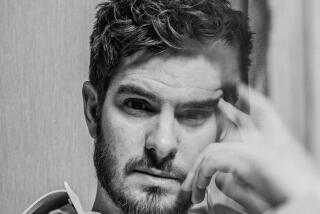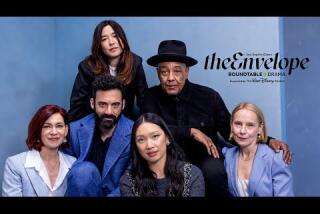One actor’s crucial advice for playing a real person? ‘Don’t be an idiot.’

Young Saniyya Sidney remembers what it was like to meet Venus Williams: “She was sweet and funny, and I connected with her.” But Sidney is also an actor at heart: She’s playing the future tennis superstar in “King Richard,” which tells the story of Venus and Serena Williams’ rise to fame via their focused, assertive father, and she made sure to observe her subject in person for clues.
“It was her walk I had to get down,” says Sidney. “Every time I had to become Venus, her walk is what I would hop into — and then I felt like her from then on.”
Sidney had the advantage of meeting the woman she’s portraying in her film, unlike a few of the many other actors playing a real person (living or dead) this awards season. This year, Jennifer Hudson is Aretha Franklin in “Respect”; Jodie Comer is Marguerite de Carrouges in “The Last Duel”; Tim Blake Nelson is a mythologized older version of a real Old West figure in “Old Henry”; Andrew Garfield is both playwright Jonathan Larson (“Tick, Tick … Boom!”) and televangelist Jim Bakker (alongside Jessica Chastain as Tammy Faye Bakker) in “The Eyes of Tammy Faye,” just for starters. And each has had to thread the needle between impersonation and interpretation to create someone real on screen.
Much depends on just how well-known the figure in question is. Many audience members will have an idea of what Aretha Franklin looks like, but Hudson does not look much like the late soul legend (as “Respect” director Liesl Tommy admits). But Tommy had other priorities than just straight-up looks.
“I wanted people who could really sing, and sing live on set,” she says. “You really have to find people … that can embody the spirit of the real person. That’s a lifetime working as a casting director, to find that ‘essence’ inside them that will match up.”
“Playing a real person is a huge responsibility, because you want the audience to turn up and believe you, even if they don’t recognize the performance,” agrees Claire Foy, who plays the wife of a tormented artist in “The Electrical Life of Louis Wain.” “I find it more stressful to play someone who isn’t as recognizable.”
Meanwhile, prosthetics and costuming can go only so far, says “Faye” director Michael Showalter. “Prosthetics can almost be seen as an obstacle to giving the performance — the actor has to almost fight through that layer to tell the story or give their performance. Costume and makeup helps the illusion that these characters are who we say they are, but it’s nothing without the performance. No performance happens without the actor.”
But no matter how extensive the makeup or outfits, the actor has to come to the set prepared to be this individual on such an instinctive level that they don’t have to think about it. Garfield see-sawed between playing convicted televangelist Bakker and “Rent” creator Larson, who died at 35, and says he had distinct challenges with each.
“You’re trying to identify the inner aspects of this person,” he says. “Outside, I could have a judgment of Jim — he’s on the wrong track — but I had to find the parts of me that were on the wrong track. I had to really dive into those aspects of myself and dive into the less spiritual impulses of myself. For Jon, it was a more pleasurable place to be: I got to access the passion of the artist, the longing to see a broken culture healed.”
Performers such as Sidney, Garfield, Chastain and Hudson are fortunate in that there’s almost endless footage of their subjects. Williams’ father, Richard, videotaped his tennis stars on their ascent; Franklin had decades of a music career; the Bakkers were in the public eye for decades. There’s less public footage of Larson, but Garfield watched “beautiful old grainy VHS footage of him” performing his one-man show “Boho Days,” and he had access to Larson’s sister and friend-archivist.
But not every actor has that option. Comer’s DeCarrouges (the victim of a sexual assault whose husband dueled on her behalf after the attack) lived in the 14th century. “There’s one eroded painting of her,” says Comer.
That left Comer, guided by the script from Nicole Holofcener, Ben Affleck and Matt Damon, and her director, Ridley Scott, to assemble the pieces to find that “essence.” “For any woman to speak out about being sexually assaulted speaks so much about that person, and it’s such a risk in doing so — but then realizing at this period in history, where women were regarded essentially as property … she feels like a ‘modern woman’ of that time,” says Comer. “She stood up, and you get a sense of character. She spoke several languages; she was extremely well-read.”
Likewise, “Old Henry” imagines what a long-dead historical figure might be like had he survived a shooting. There is a photo of the real McCarty, but as Nelson points out, “he’s posing and presenting a mythological version of himself already. So the fun became balancing that with finding a real guy inside there and exposing it over the course of a movie, because ‘Old Henry’ is about the unmasking of a person.”
Whatever road is taken to get to that essential spirit of a character, though, actors and directors agree that it needs to feel truthful enough so that when the cameras go on, they can believe in the role they’ve created instinctively. Tommy hired speech and movement coaches for “Respect,” but it was the actors who had to be able to slip into them the moment they arrived for shooting.
“Everyone was bringing clear, prepared performances that allowed us to be free on set. When they’re not worried about your accent or vocal placement, because we’d sorted that out already, then you can encourage artists to make exciting choices,” she says.
And if all else fails, the artist can keep in mind that they’re representing a real person on screen — and may be the only way millions ever truly understand that character.
“You have to approach every character as another human being,” says Foy. “Don’t be an idiot. Be sensitive, interested, listen — and whatever you do, don’t be over the top about that person.”
“Don’t be an idiot” is one thing, but Garfield recalls having other concerns about stepping into Larson’s shoes. “I remember saying to Lin [Manuel Miranda, “Tick” director] that I’m glad he framed Jon to be in a certain way, but it was really much more of a pressure not to be haunted by the ghost of Jonathan Larson for the rest of my life.”
More to Read
From the Oscars to the Emmys.
Get the Envelope newsletter for exclusive awards season coverage, behind-the-scenes stories from the Envelope podcast and columnist Glenn Whipp’s must-read analysis.
You may occasionally receive promotional content from the Los Angeles Times.







